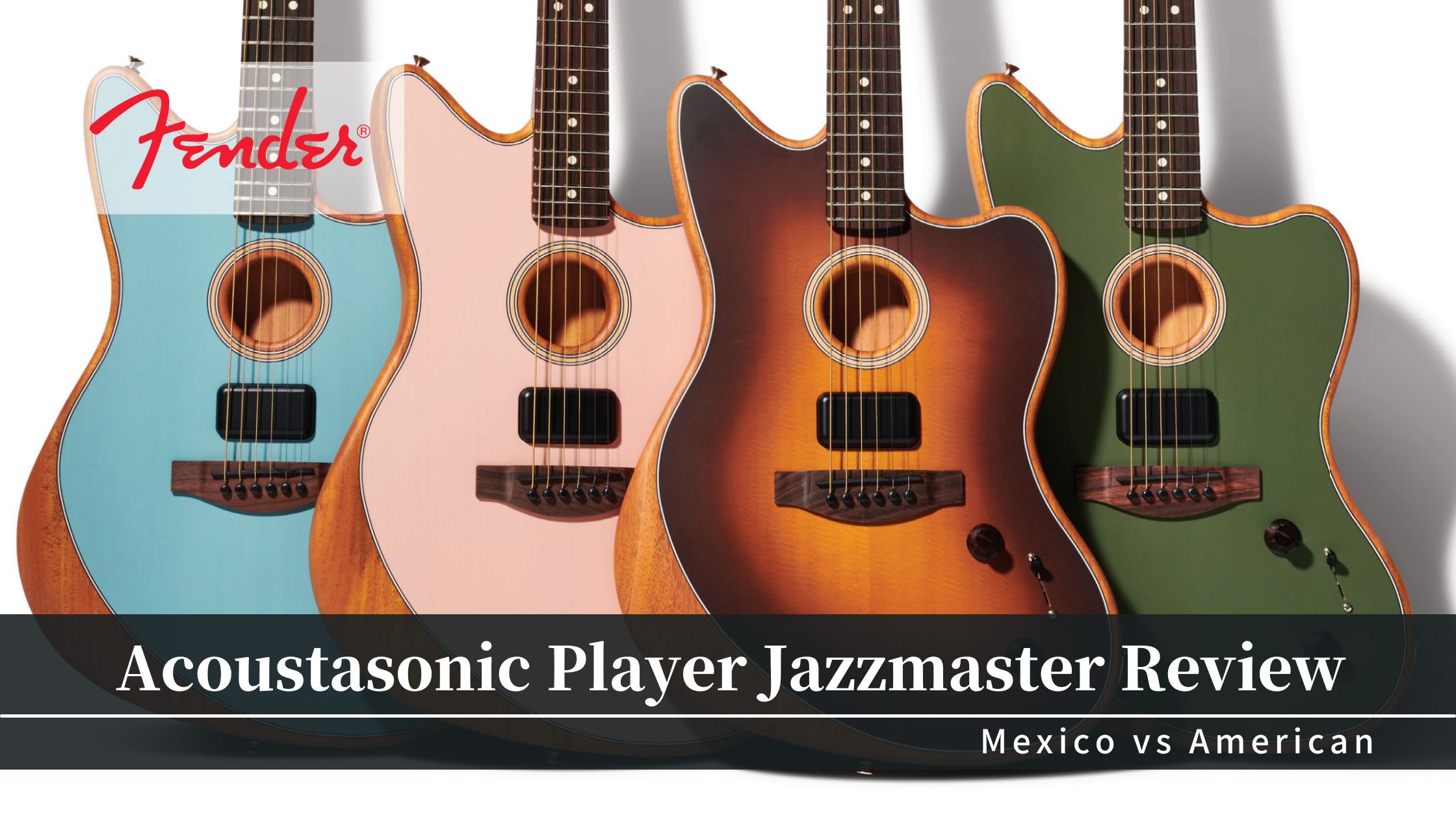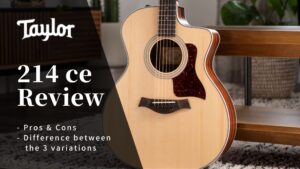Acoustasonic is equipped with a humbucker, priced at $1,199.99. With a tube combo amp, you can output both electric and acoustic sounds using just this one instrument. More suitable for easy recording with an acoustic sound than an acoustic-electric with a piezo pickup. The natural sound isn't too loud, making it recommended for casual playing at home. If you desire body hit sounds like slap and slam techniques, the USA-made version is recommended.
For those who:
● Want both electric and acoustic sound.
● Desire a simple acoustic sound for line recording without a mic.
● Wonder about the differences between the Mexico-made and USA-made Acoustasonic Jazzmaster.
Hello, I am Yosh(@Yosh_Guitars), an ex-music store clerk. In November 2022, the Mexican-made “Acoustasonic Player Jazzmaster”, a hybrid of electric and acoustic, is released. This article reviews its features, benefits, recommended amplifiers when in use, and differences from the American-made American Acoustasonic Jazzmaster.
Pros of Acoustasonic Player Jazzmaster
Hybrid of Acoustic and Electric Guitar
The Acoustasonic series is an original design by Fender, adopting a patented soundhole structure called the Stringed Instrument Resonance System (SIRS). Although it has a much thinner body than a typical acoustic guitar, its natural sound is just like an acoustic guitar. The original pickup system allows for real acoustic sound output from the amplifier. Additionally, it is equipped with a magnetic pickup like an electric guitar, allowing for electric guitar sounds as well.
Electric-like Playability with Acoustic Sound
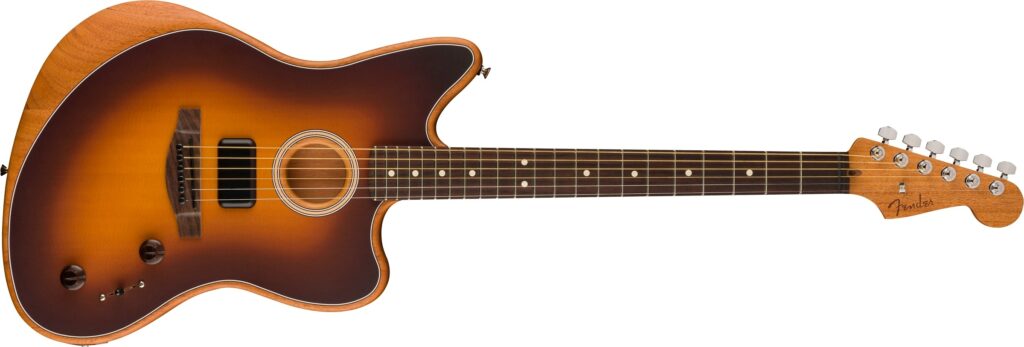
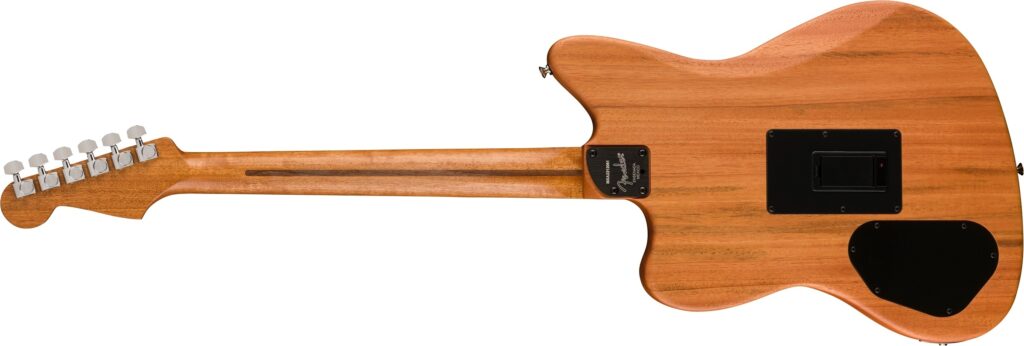
While the sound is predominantly acoustic, it offers the comfortable playability of an electric guitar. The neck shape is a common C-shape found in electric guitars. The neck grip feels close to an electric guitar, and the body’s thinness and cutaway make playing on high frets smooth.
Equipped with Humbucker Pickup
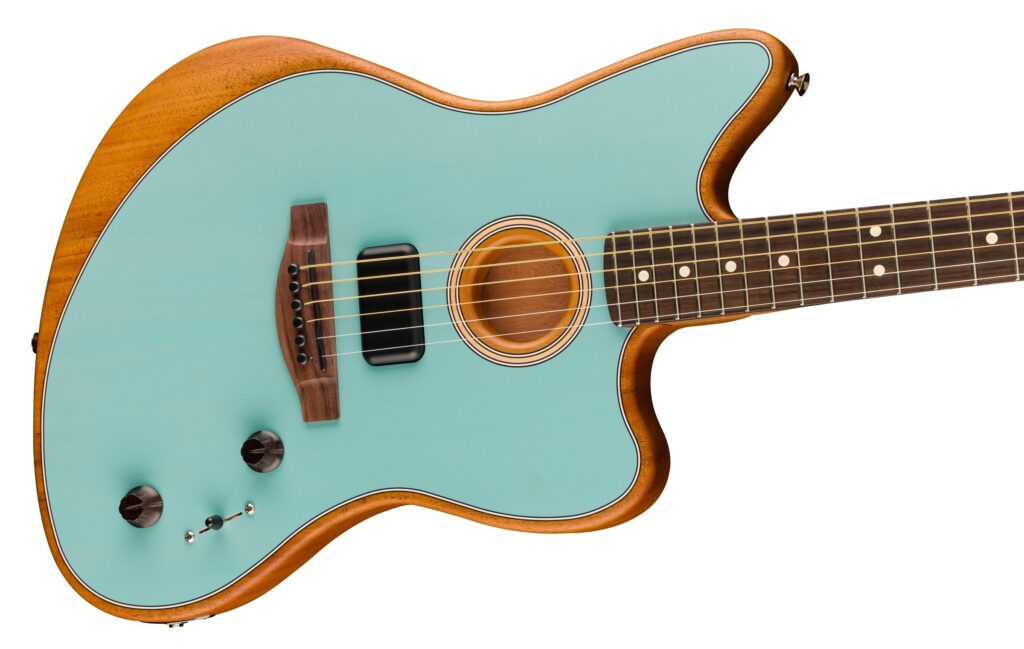
The Acoustasonic Jazzmaster is equipped with a humbucker designed by Tim Shaw, who developed pickups for Gibson in the 1980s and now works for Fender. This provides a dense sound different from the single-coil pickups found in the Acoustasonic Telecaster and Stratocaster.
Loudest Natural Resonance in the Series
Among the Acoustasonic series, which includes Telecaster, Stratocaster, and Jazzmaster shapes, the Jazzmaster shape has the largest volume. This results in a louder natural resonance with strong bass.
Internal Sound Voice List
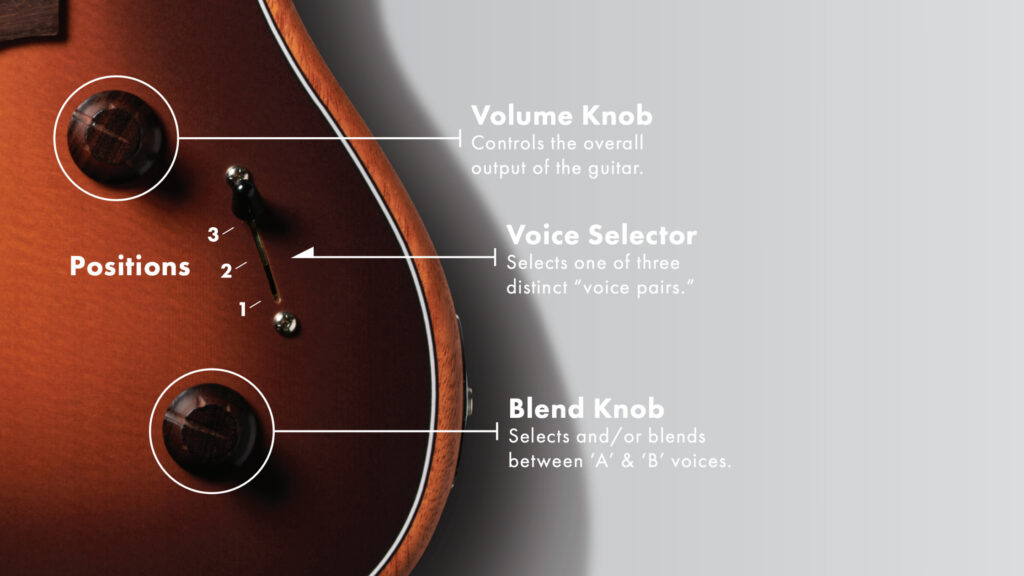
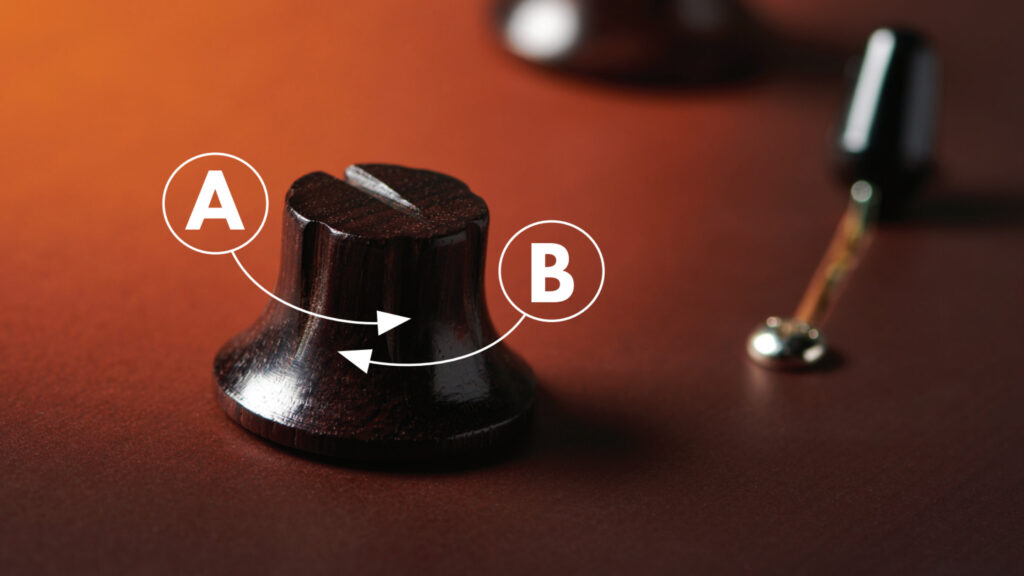
The pickup selector switches positions, and the blend knob seamlessly blends between A and B sounds.
| Sound | A | B |
|---|---|---|
| Position 1 | Fender Electric Shawbucker Clean: High-output electric clean tone designed by Tim Shaw. | Fender Electric Shawbucker High Gain: Distorted tone ideal for crunchy rhythm and sharp leads. |
| Position 2 | Piezo Clean: Acoustic tone based on the resonance of the piezo pickup and Jazzmaster body. | Lo-Fi Piezo: Adds distortion to the piezo, replicating a tone that sounds both acoustic and electric simultaneously. |
| Position 3 | Rosewood Concert Body with Slotted Headstock: Sound similar to Martin 00-28 with a slotted head, ideal for fingerstyle. | Mahogany Dreadnought: Sound reminiscent of Martin D-18, combining deep bass and articulation in an acoustic tone. |
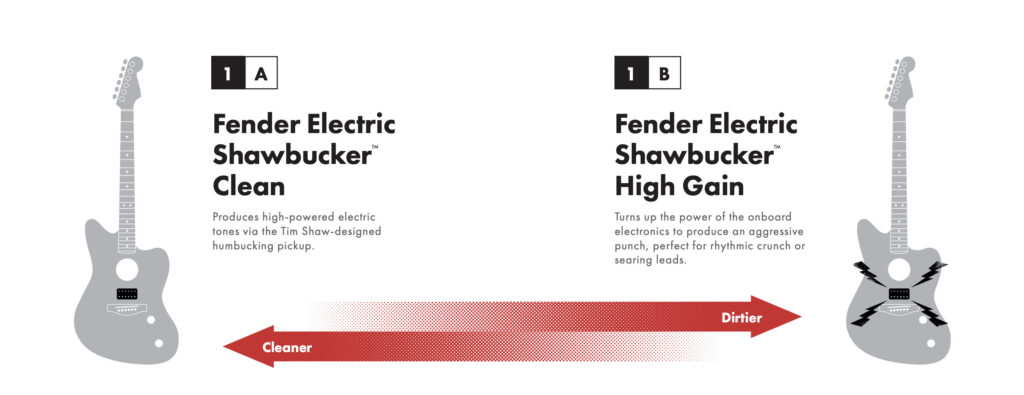
Position 1: This is the sound of an electric humbucker. While it offers a pure clean tone, it’s also possible to mix in a bit of distortion. Due to its unique body structure and acoustic guitar strings, it produces an electric sound with a sense of airiness, distinct from a solid electric guitar.
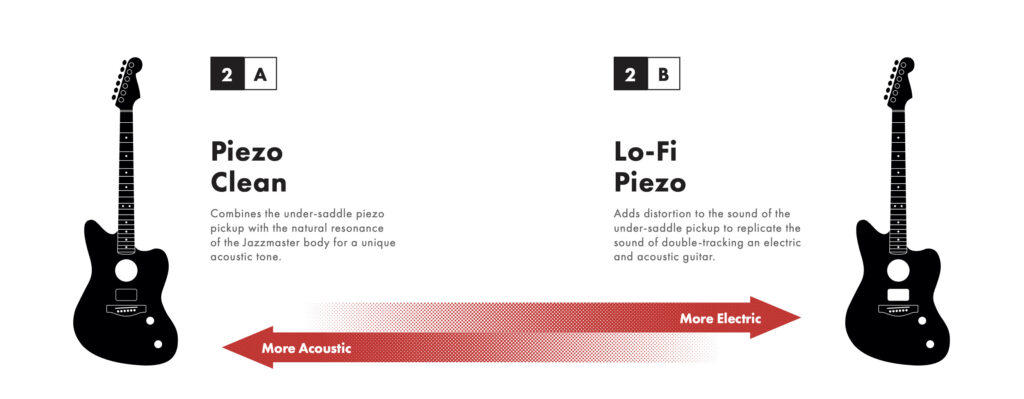
Position 2: This is the sound of a piezo pickup, capable of producing an acoustic sound similar to many acoustic-electric guitars. By blending A and B, you can achieve a sound that seems like a simultaneous blend of an acoustic and a distorted electric guitar.
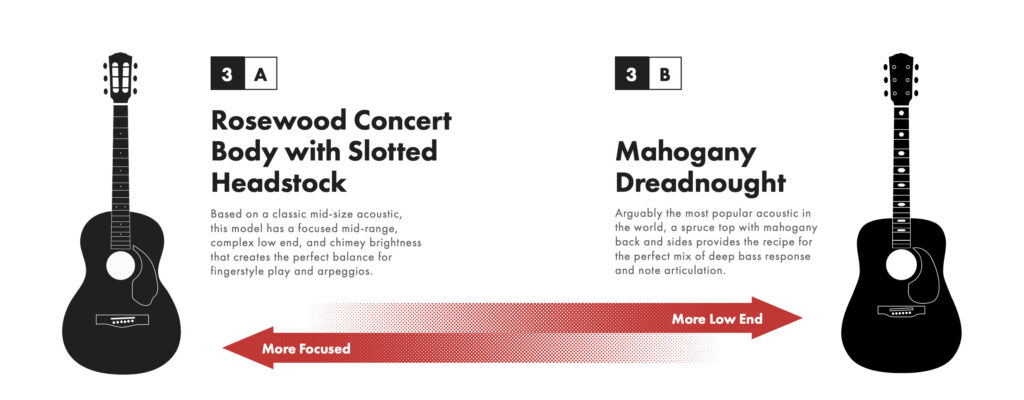
Position 3: The sound picked up by the piezo is converted into a modeled sound that replicates the resonance of an acoustic guitar. When output through a line or amp, you can achieve a more natural acoustic sound that many desire, more so than from acoustic-electric guitar with piezo pickups like Takamine. You can easily produce a realistic acoustic sound, more effortlessly than with acoustic-electric with piezo pickups or the challenges of microphone recording. You can mix contrasting tones: the sparkling sound derived from a small body with rosewood sides and back, and the powerful bass-rich acoustic sound from a dreadnought with mahogany sides and back. Without using EQ, you can effortlessly achieve a natural and ideal acoustic sound.
Con: Importance of Amplifier and Sound Creation for Ideal Sound
While the Acoustasonic can produce both electric and acoustic sounds, it’s essential to be mindful of the amplifier you use.
You know how when you connect an electric-acoustic guitar to an electric guitar amp, you don’t get a pure acoustic sound, right? The Acoustasonic is fundamentally the same. Conversely, if you connect an electric guitar to an electric-acoustic amp, the sound becomes too hi-fi, resulting in a tone that lacks warmth.
Depending on which sound you prioritize, you should choose your amplifier accordingly.
The recommended amplifier for use with the Acoustasonic is a tube combo amp. Classic choices include the Fender series like the Twin Reverb, and more recent options like the SHINOS Rocket.
With these, you can achieve a warm sound characteristic of electric guitars and, though the range might be a bit narrow, a sound that is unmistakably acoustic upon listening.
Comparison: Mexico vs. USA – Differences between Acoustasonic Player Jazzmaster and American Acoustasonic Jazzmaster
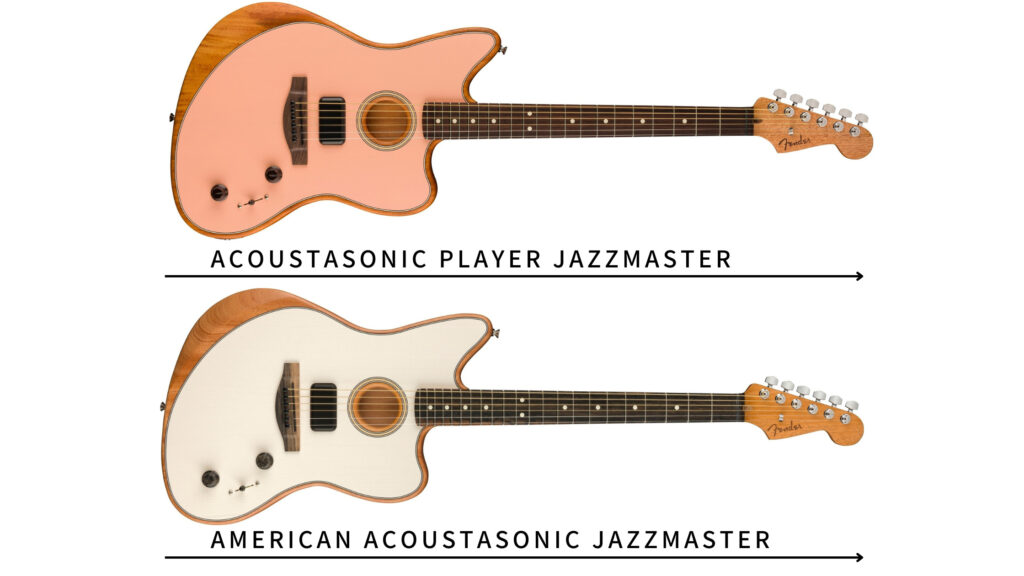
| Specification | Acoustasonic Player Jazzmaster | American Acoustasonic Jazzmaster |
|---|---|---|
| Market Price | $1,199.99 | $1,999.99 |
| Country of Production | Mexico | USA |
| Body | Mahogany | Mahogany |
| Body Top | Solid Sitka Spruce | Solid Sitka Spruce |
| Neck | Mahogany | Mahogany |
| Neck Shape | Modern “Deep C” | Modern “Deep C” |
| Fretboard | Rosewood | Ebony |
| Frets | 22 Narrow Tall | 22 Narrow Tall |
| Scale | 25.5″ (647.7mm) | 25.5″ (647.7mm) |
| Fretboard Radius | 12″ (305mm) | 12″ (305mm) |
| Nut | Graph Tech TUSQ | Graph Tech TUSQ |
| Nut Width | 1.6875″ (42.86 mm) | 1.6875″ (42.86 mm) |
| Controls | Volume, Blend Knob, 3-Way | Volume, Blend Knob, 5-Way |
| Pickups | 2 (Under-saddle Piezo, Acoustasonic Shawbucker) | 3 (Under-saddle Piezo, Acoustasonic Shawbucker, Body Sensor) |
| Number of Voices | 6 types | 10 types |
| Power Source | 9V Battery/20 hours | Built-in rechargeable battery/Up to 20 hours |
| Case | Deluxe 1225 Gigbag | Deluxe 1225 Gigbag |
| Strings | Phosphor Bronze 11-52 | Phosphor Bronze 11-52 |
| Colors | 2-Color Sunburst, Shell Pink, Antique Olive, Ice Blue | Ocean Turquoise, Natural, Tobacco Sunburst, Tungsten, Arctic White |
The Acoustasonic Player Jazzmaster and the American Acoustasonic Jazzmaster have the following differences:
- Price
- Wood and precision due to the country of production
- Presence or absence of an internal body sensor pickup
- Number of built-in voices
- Battery
Difference 1: Price
The production factories and the following differences result in a price of $1,199.99 for the Mexican model and $1,999.99 for the American model, with a price difference of $800.
Difference 2: Precision and Wood Due to Production Country
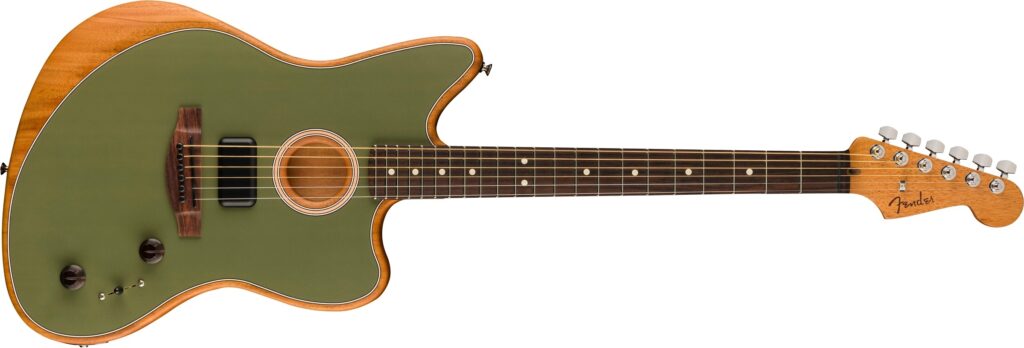
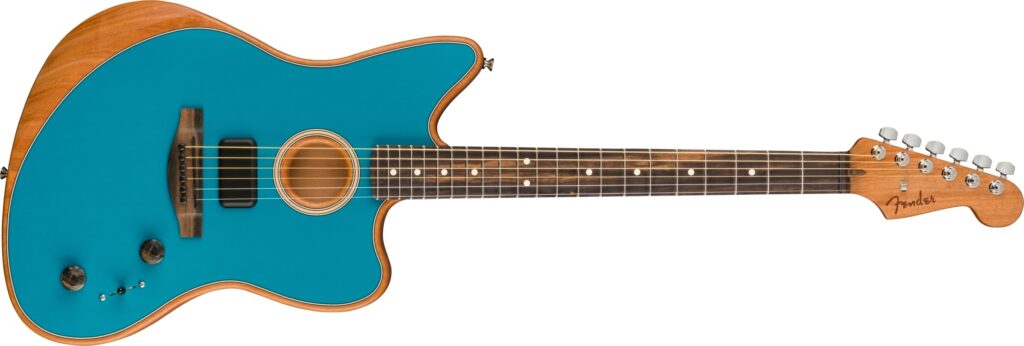
Player (Rosewood Fingerboard & Bridge) vs. American (Ebony Fingerboard & Bridge): The fingerboard and bridge wood for the Mexican model is rosewood, while the American model uses ebony. However, you don’t need to worry about the impact on sound due to the difference in wood. The other woods are the same, and the sound output is processed by the pickups and built-in voices mentioned later. Especially when comparing the production countries (factories) that significantly affect the cost, the quality is not so different. Indeed, the American model seems to have superior nut groove cutting and fitting precision. However, the Mexican model also has a high-quality finish on the neck and fret edges, providing a stress-free experience. The individual I observed did not have any noticeable paint roughness.
Difference 3: Presence or Absence of Body Internal Sensor Pickup
Both models are equipped with a dedicated humbucker for electric (Acoustasonic Shawbucker) and a Fishman-made under-saddle piezo. The American model also has an internal body sensor. This adds a sense of air and depth to the body’s resonance, producing a more realistic acoustic sound. It also picks up body hit sounds, so for players who use slap techniques or loopers, the American model is recommended.
Difference 4: Number of Built-in Voices
Due to the Mexican model having one less pickup, there are 6 types of sound changes by the pickup selector. The American model has 10 types. The American Acoustasonic Jazzmaster’s tones are as follows:
| Sound (Position) | A | B |
|---|---|---|
| Position 1: Electric | Electric Fat/Semi-Clean: Clean electric sound from the humbucker PU. | Electric Overdrive: Overdrive sound from the humbucker PU. |
| Position 2 | Lo-Fi Piezo: Electric-acoustic sound solely from the piezo pickup. | Lo-Fi Piezo Crunch: Blend of overdrive sound with the piezo sound. |
| Position 3: Percussion & Enhanced Harmonics | Rosewood Auditorium: Similar to Martin 000-28. Tight and bright, suitable for both strumming and fingerstyle. | Blend with Internal Pickup: Blend of acoustic sound with body hits and harmonics. |
| Position 4: Alternative Acoustic | Mahogany Jumbo: Similar to Gibson SJ-100. A loud acoustic sound with a sense of airiness. | All Mahogany Small Body: Warm and tight sound suitable for fingerstyle. |
| Position 5: Core Acoustic | Rosewood Dreadnought: Similar to Martin D-28. Warm, clear, and rich in harmonics acoustic sound. | Mahogany Slope Shoulder: Similar to Gibson J-45. Dry and organic sound suitable for strumming. |
The humbucker sound and the piezo pickup sound are almost the same characters, with a combination of clean and distortion. On the other hand, the American model has a wider variety of acoustic sounds, especially with the internal sensor pickup.
Difference 5: Battery
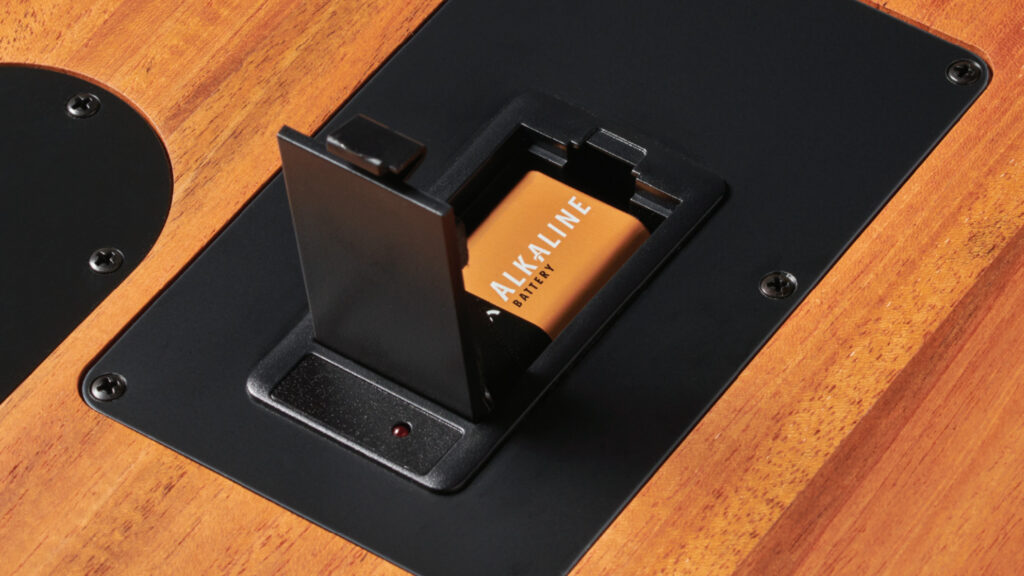
The power source for the Mexican model is a 9V battery commonly used in effectors, while the American model has a built-in battery that can be charged with a micro-USB cable. Both have an operating time of approximately 20 hours.
Conclusion: How to Choose
The Mexican-made Acoustasonic Player Jazzmaster is recommended for those who:
- Want to produce both electric humbucker and acoustic sounds with a single guitar.
- Desire an acoustic sound with the playability of an electric guitar.
- Find the volume of a regular acoustic guitar too loud for home use.
- Want to casually play at home without connecting to an amp, but still desire good sound quality.
- Don’t need body hit sounds and prefer the option that’s about 100,000 yen cheaper.
- Want to line out modeling sounds with the richness of an acoustic guitar, rather than the grade of acoustic-electric like Takamine.
The USA-made American Acoustasonic Jazzmaster is recommended for those who:
- Want to output slap techniques through a line.
- Want to add percussive sounds using a looper.
- Desire an even more realistic acoustic sound provided by the body sensor.
- Want to explore sound creation with a rich variety of built-in tones.

